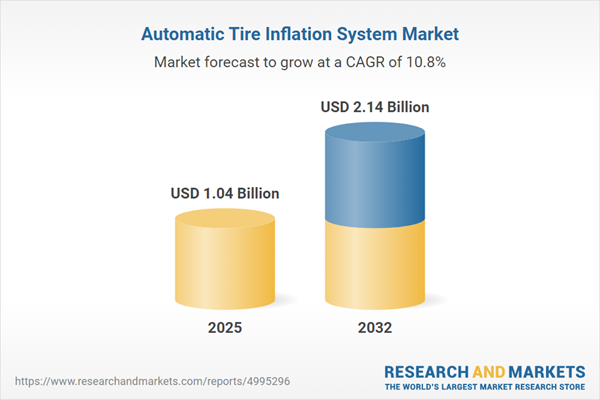Speak directly to the analyst to clarify any post sales queries you may have.
Automatic tire inflation systems are becoming a strategic asset for fleet operators and logistics leaders, streamlining operations while supporting regulatory compliance and risk management initiatives. As the transportation sector demands greater agility and uptime, adopting these technologies positions organizations to navigate dynamic industry challenges efficiently.
Market Snapshot: Automatic Tire Inflation System Market Size, Trends, and Outlook
The global automatic tire inflation system market is valued at USD 943.07 million in 2024 and is forecast to rise to USD 1.04 billion by 2025. Long-term projections estimate the market will approach USD 2.14 billion by 2032, underscoring a consistent compound annual growth rate of 10.81%.
Growing interest from both commercial and passenger vehicle segments continues to propel market expansion, as companies pursue streamlined fleet operations and compliance strategies. Senior leaders are prioritizing investments in automatic tire inflation systems to enhance safety, ensure seamless regulatory alignment, and reinforce their market position across diverse fleet profiles and geographies.Automatic Tire Inflation System Market: Scope & Strategic Segmentation
- Vehicle Types: Heavy commercial vehicles increase operational uptime with these solutions, while light commercial vehicles and passenger cars benefit from optimized tire performance and reduced maintenance requirements.
- Technologies: Centralized systems, leveraging wired and wireless connections, support rapid diagnostics and automated tire pressure adjustments using integrated sensors and valves for accurate, real-time management.
- Distribution Channels: Aftermarket offerings enable retrofitting of existing fleets, and OEM channels deliver solutions embedded in new vehicles, allowing for coordination with fleet renewal strategies.
- End Users: Fleet management organizations, logistics providers, and integrated transport operators are adopting these systems to maintain compliance standards and improve operational reliability across continuous and diverse fleet operations.
- System Types: Digital and electronic platforms enable analytics-driven management suitable for technology-forward enterprises, whereas mechanical systems appeal to operators who value streamlined and straightforward processes.
- Regions: Adoption is robust in North America and Europe due to regulatory encouragement and advanced infrastructure, while Asia-Pacific and the Middle East & Africa are tailoring adoption strategies to local compliance and operational requirements.
- Leading Companies: The sector features key players driving technology innovation and global collaboration, including Meritor, ZF Friedrichshafen, Continental, Timken, Michelin, Goodyear Tire & Rubber, Bridgestone, SLIME Industries, Alert Products, and TireMinder.
Key Takeaways for Senior Decision-Makers
- Integrating automatic tire inflation systems with IoT capabilities supports predictive maintenance and efficient fleet planning, offering leaders data-driven insights that enhance operational oversight.
- Deploying advanced inflation technologies extends asset lifespans, strengthens fleet sustainability efforts, and facilitates adherence to evolving compliance measures.
- Real-time connectivity enables seamless interfacing with telematics solutions, providing clear performance visibility and supporting decision-making across widely distributed fleet assets.
- Flexible system options, including OEM and aftermarket solutions, help organizations synchronize procurement approaches with strategic investment timelines.
- Scalable platform designs accommodate diverse organization sizes and requirements, allowing customization to both established budgets and evolving technological infrastructures.
- Global solution providers are aligning product standards to support market consistency, while fine-tuning offerings to address both regulatory mandates and unique operational demands in different regions.
Tariff Impact: Navigating Supply Chain and Cost Considerations in 2025
Ongoing changes to U.S. tariffs on automotive components require organizations within the transport sector to revisit procurement strategies. Senior decision-makers are emphasizing resilient supplier relationships, evaluating regional sourcing, and advancing compliance protocols. These actions support continuity and business agility across affected supply chains as trade policies evolve.
Methodology & Data Sources
This market analysis is based on direct input from industry specialists, alongside interviews with OEMs, prominent suppliers, and major fleet operators. Technical assessments ensure data accuracy, providing leaders with actionable insights that inform technology selection, procurement, and implementation strategies within the automatic tire inflation system market.
Why This Report Matters
- Assists executives in optimizing fleet strategies through the adoption of automatic tire inflation systems that directly contribute to risk mitigation and operational stability.
- Clarifies principal market drivers, outlining actionable approaches to sustaining supply chain resilience and supporting ongoing compliance initiatives.
- Equips decision-makers with targeted insights for effective vendor engagement, robust technology selection, and adaptive procurement under shifting industry conditions.
Conclusion
Automatic tire inflation systems provide a resilient framework for achieving operational agility in the transportation sector. Leveraging these solutions equips organizations to proactively respond to change, ensuring long-term performance, compliance, and adaptability in dynamic operating environments.
Additional Product Information:
- Purchase of this report includes 1 year online access with quarterly updates.
- This report can be updated on request. Please contact our Customer Experience team using the Ask a Question widget on our website.
Table of Contents
3. Executive Summary
4. Market Overview
7. Cumulative Impact of Artificial Intelligence 2025
Companies Mentioned
The companies profiled in this Automatic Tire Inflation System market report include:- Meritor, Inc.
- ZF Friedrichshafen AG
- Continental Aktiengesellschaft
- The Timken Company
- Michelin SCA
- The Goodyear Tire & Rubber Company
- Bridgestone Corporation
- SLIME Industries, LLC
- Alert Products, Inc.
- TireMinder, LLC
Table Information
| Report Attribute | Details |
|---|---|
| No. of Pages | 181 |
| Published | October 2025 |
| Forecast Period | 2025 - 2032 |
| Estimated Market Value ( USD | $ 1.04 Billion |
| Forecasted Market Value ( USD | $ 2.14 Billion |
| Compound Annual Growth Rate | 10.8% |
| Regions Covered | Global |
| No. of Companies Mentioned | 11 |









